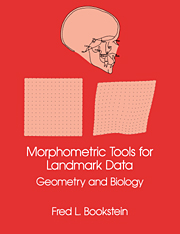1 - Introduction
Published online by Cambridge University Press: 23 November 2009
Summary
Morphometrics is the study of covariances of biological form.
The objects of morphometric study are not the forms themselves, but rather their associations, causes, and effects. This book treats the theory and practice of such studies in their most important special case, the application to landmark data. Most of the text introduces and exemplifies a diversity of modern geometric tools that increase the sensitivity and specificity of biological explanations of form. In this introductory chapter I tersely present the four main design principles of these tools and lead the reader through a typical example to demonstrate their interplay. The example is followed immediately by a second introduction aimed at the reader more conversant with statistics than with biology. The chapter closes with a brief sketch of the organization of the rest of the book.
FOUR PRINCIPLES
Many logical and methodological themes recur throughout this book. I have collected them here in the guise of “principles,” tenets the meanings and implications of which will echo again and again in the theorems, constructions, and examples to follow. The principles appear together in this section and the next and then go their separate ways throughout the next six chapters. Chapter 8 draws them together again to serve as a framework for the summary of the techniques recommended here as “routine.” Their limits, also mentioned many times in Chapters 2 through 7, will suggest the closing speculations of Chapter 8 on new tools for the next edition of this tool kit.
First Principle: landmark locations
In many biological and biomedical investigations, the most effective way to analyze the forms of whole biological organs or organisms is by recording geometric locations of landmark points.
- Type
- Chapter
- Information
- Morphometric Tools for Landmark DataGeometry and Biology, pp. 1 - 19Publisher: Cambridge University PressPrint publication year: 1992



